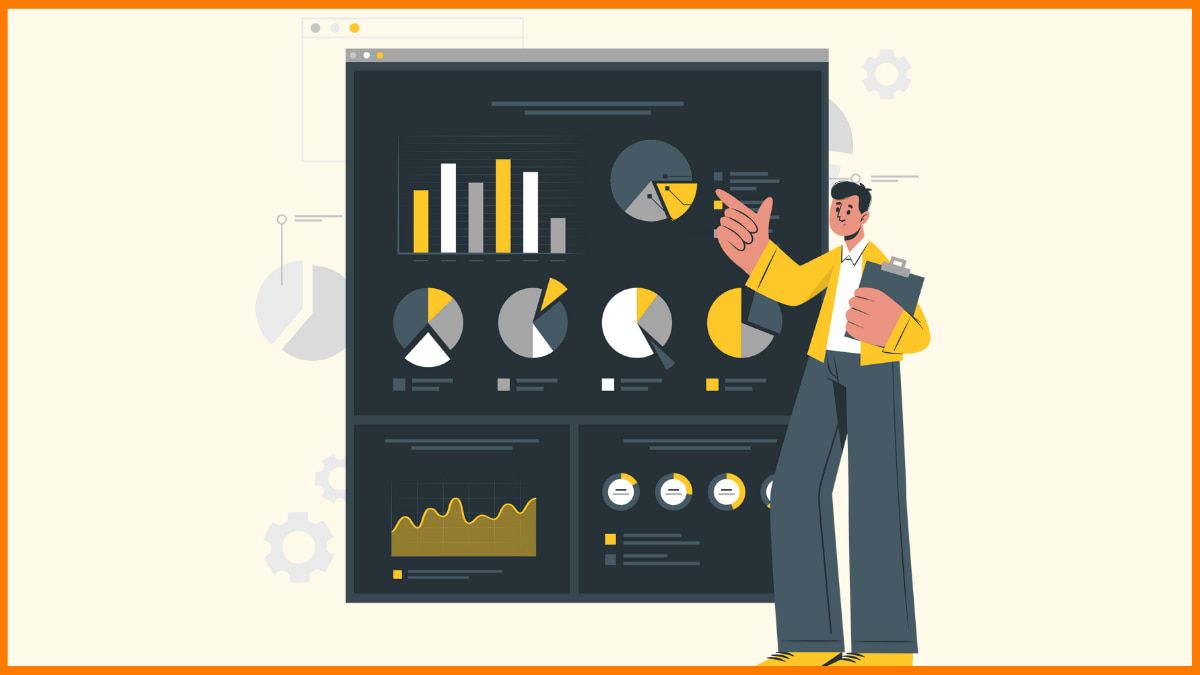How Do Companies Use Mobile Analytics to Improve Their App?
🔍Insights
Seventy percent of screen time is devoted to smartphones. A large percentage of this time is spent on apps. Such tremendous interest is fantastic news for you as an investor in the technological market. Simultaneously, the mobile app industry is quite crowded. If there's one app for an issue, there's probably another (or ten) available.
How can you remain above the curve while every application in the industry claims to be the next great thing? What strategies do you employ to ensure your software is unique? That's when mobile analytics come into play.
What Is Mobile App Analytics?
Types of Mobile Analytics
Mobile Analytics versus Standard Web Analytics
Different Ways Mobile Analytics Is Used by Multiple Departments in a Company
What Is the Most Effective Technique to Obtain Analytics for Applications?
Is Google Analytics Compatible With Mobile Apps?
Best Mobile Analytics Tools
What Is Mobile App Analytics?
The collection and assessment of data – the data that makes you learn your customers' behaviour and how they engage with your app – is called mobile analytics.
This unlocks a slew of options, such as gaining information about the number of converts and customers, as well as a better understanding of your consumers' experience within your app.
Ultimately, it clarifies the objectives of users–do they want to purchase stuff? Is it merely for the purpose of obtaining data? Or are they simply browsing?
Types of Mobile Analytics
There are various forms of mobile analytics, each one improving your app in a unique way. To make the most of these mobile analytics sorts, keep in mind your company's demands and objectives.
Mobile Advertising Analytics
You can track the efficacy of your promotional activities using mobile advertisements or marketing analytics.
App Monetization Analytics
App monetization analytics can help you learn more about your consumers' app purchases. With this data, you may devise tactics to increase the profitability of your app.
In-App Engagement Analytics
In-app engagement analytics allows you to monitor user behaviour within the app. Learning how your app's customers engage with it is a great method to constantly improve.
App Store Analytics
App store metrics can be accessed via app stores or a 3rd party solution. You may track optimization metrics like:
- App download and installations with this form of analytics.
- Rating
- Earnings
- Systems
- Venues
You may compare your application to your rivals in app stores by employing a 3rd party analytics tools.
Performance Analytics
Performance analytics is critical for determining the efficiency of your app. Many consumers will uninstall your app if it doesn't function properly. You must evaluate all potential permutations of devices, OS, and other aspects to fully comprehend your app's functionality.
Mobile Analytics versus Standard Web Analytics
Let's look at the differences between mobile analytics and standard web analytics now. On portals, web analytics gather user information. For using web analytics, you must include a JavaScript code snippet in your site's HTML source code. It'll then begin collecting info and utilizing cookies to discover web traffic. Web analytics tools keep records of both desktop and mobile visitors' info.
Mobile analytics is for smartphone and tablet applications. It tracks data via SDKs rather than prefetching, and customers are identified by their gadget or OS ID. Remember that each OS has its own SDK.
Moreover, unlike conventional analytics, mobile analytics excludes info from search engines because consumers access apps through their phones rather than through search engines. If your app connects with other apps, certain mobile analytics systems also help track inter-app interoperability. Also, because these elements impact your app, app analytics gives insight into consumers' devices. Web designers should try and ensure their designs are attuned.
Different Ways Mobile Analytics Is Used by Multiple Departments in a Company
To collect data, analytics solutions are frequently connected with organisations' native applications. It ensures that the time and work put into designing the app does not go in vain. Also, it tells you where your customers are drifting off and what hurdles they're hitting during the onboarding.
When it pertains to refining and optimising the UX, the ideas gleaned from analytics data are immediately relevant for various teams within the firm.
Marketing
A market study is done using mobile analytics. It allows firms to monitor and assess the efficacy of their marketing efforts, as well as determine which platform is the most effective. This aids in the proper management of your marketing initiatives.
UX/UI
Heatmaps and session replay aid UX professionals in focusing primarily on the majority of your app's user-interacted sections. Heatmap is a data visualisation tool that displays how your smartphone users engage with the UI by clicking, tapping, scrolling, etc.

Session replay recreates the user's experience in the format of replay clips and accentuates the user's full touch engagements. This study enables them to carefully position CTAs, improve navigation, and utilise screen features to provide a streamlined experience.
You may delve deeper into a whole set of users by integrating session replays and conversion funnels and monitoring the deviation and true customer behaviour.
Product
A/B testing allows product managers to assess their customers by dividing them into 2 (or more) sets and observing how each variation influences their behaviour. Product managers can use tools like usage monitoring to uncover trends that will assist them to make decisions as they make modifications and send out fixes.
After taking recourse, product managers must ensure that it has the desired effect. When making judgments, they consider conversion rates, the most frequently utilized screens, app versions, devices, and OS.
Establishing funnels for certain user groups is an intriguing use case. Using session replays to see into the funnel lets product members discover why a certain customer took a specific function and where they were experiencing trouble. This assists in finding the precise setting of customer drop-offs and other prominent user resistance spots.
Engineering
App failures and ANR are two of the most common causes of customer dissatisfaction. Technical experts can employ heatmaps and session replay to monitor crucial usage patterns like anger taps, extended presses, quit touch, and inattentive touches, which signal displeasure.
Heatmaps assist groups in visualising the stage at which customers become irritated. The mix of session replays and heatmaps reveals the list of steps that users take well before exiting the programme.
Crash analytics paired with heatmaps enables you to rerun the user's onscreen activity and discover what caused the crash. This takes away the ambiguity for tech personnel, allowing them to focus on tackling the issue without having to deal with already irritated users.

What Is the Most Effective Technique to Obtain Analytics for Applications?
For that, you'll need to use mobile app advanced analytics. Because each piece of equipment has its range of attributes, you choose something that suits your needs.
These tools are typically simple to set up and utilise. All you have to do is include SDKs in the programme you wish to track. The programme will begin collecting data constantly so you can keep track of your app. You can quickly acquire meaningful information about user behaviour and the effectiveness of your app using mobile analytics services.
Create a UX Map
It depicts the consumer journey using your phone app from the start. You'll learn which parameters to track and when users often discontinue using your application if you study their experiences. This way, you'll be able to pinpoint exactly which phases of the user's journey need to be improved in order to increase income.
Use it at Each Stage
Don't delay until a problem occurs with your application to begin using analytics. It'll be much simpler to spot and solve issues if you try integrating analytics for your application from the start.
Determine the Variables You Ought to Monitor
There seem to be a lot of variables to detect, and if you don't figure out which ones are most vital to a company first, you'll waste time and money on the ones that aren't. As a result, ensure to outline your objectives and then select the appropriate measurements to achieve them.
Evaluate Your App
Ensure you check your app in a variety of scenarios to ensure that it meets the requirements. A/B testing is a wonderful way to figure out how to improve your app's exchange rate.
Use Tools
The greatest method to learn how to optimise your app while improving efficiency is to utilize app analytics programs and tools. There are a plethora of mobile analytics systems to select from, so ensure you pick something that's right for you. However, not every mobile analytics are same. There are several mobile analytics options available. UserExperior, Google's Firebase, and others are instances of mobile analytics solutions that, while similar, are not exclusive and handle various challenges.
Qualitative Analytics encompasses previously mentioned capabilities such as heatmaps and session replay and is probably highly recommended for every firm's stack.
Early investors of QA Solutions include Lenskart and ICICI Prudential Life Insurance, which have experienced a strong influence on their application service quality and customer loyalty. Replays of sessions and heatmaps are wholly accountable for a 95 percent reduction in service SLA and for repairing the disrupted UX.
Is Google Analytics Compatible With Mobile Apps?
Yes, you may utilise Google Analytics tools for phone analytics. Google Analytics for smartphone apps or Google Analytics for Firebase is the two possibilities. You may use services for gratis, but you'll have to pay to get access to all of the services. It's a free service provided by Google.
For Mobile Apps
You can monitor user behaviour on your portal and apps for free with Google Analytics. You must use Google Analytics SDK for Android or ios to configure analytics for the app.
It can assist you in two steps:
- Recognising the most successful lead streams
- Segregating your app's customers
- Monitoring user engagements
- Analyzing in-app purchase income
- Analyzing user travel pathways
Google Analytics gives the following info about your app:
- Count of users and visits
- Session duration
- OS
- Device forms
- Users' residence
For Firebase
It's more than simply an analytics software; it's also a framework for developing apps. Firebase uses events and variables to record user behaviour. It allows you to update on up to 500 different occurrences at once.
This utility allows you to accomplish the following:
- Recording user characteristics and events
- Configuring unique events
- Recording in-app purchasing data
- Creating target markets
- Seeing real-time user information
Best Mobile Analytics Tools
Rather than Google Analytics, you can utilise a variety of additional mobile analytics solutions. Most of them even have additional functionality that Google Analytics does not. They're as follows:
1. Countly

It's an app analytics solution that aids in the enhancement of the user experience. It helps to build unique events to track which activities have the greatest impact on your conversions and retention levels.
Features
- Push alerts
- Crash analysis
- User ids
- In-app use metrics.
2. Localytics

It's a mobile analytics tool that allows you to tailor your app ads in order to boost user experience. This tool aids in attaining better knowledge of your app's customers so that you can urge them to continue using it.
Features
- Funnel analysis
- Push alerts
- Event monitoring
- Retentions monitoring
3. Adjust

It's a mobile app analytics tool that allows you to analyse how people interact with your app. You'll be capable of making better marketing decisions and driving profits with this tool.
Features
- Funnel analysis
- Retention monitoring
- Revenue monitoring
- Event monitoring
Conclusion
When it comes to creating a product that catches the eye, there are a few things to keep in mind. You'll need a 360-degree view of your app. This ensures that your customer base is committed and satisfied with your brand, and mobile analytics solutions are essential for this.
FAQs
What are companies that use mobile analytics?
Adobe, Clicktale, Google, IBM, and InnoCraft are some of the companies that use mobile analytics.
What is mobile data analytics?
Mobile data analytics monitors customer behaviour and helps companies understand how customers are interacting with their apps.
Why is mobile analytics important?
Mobile analytics is important as it helps brands optimize their performance and improve their app.
Must have tools for startups - Recommended by StartupTalky
- Convert Visitors into Leads- SeizeLead
- Website Builder SquareSpace
- Manage your business Smoothly Google Business Suite






